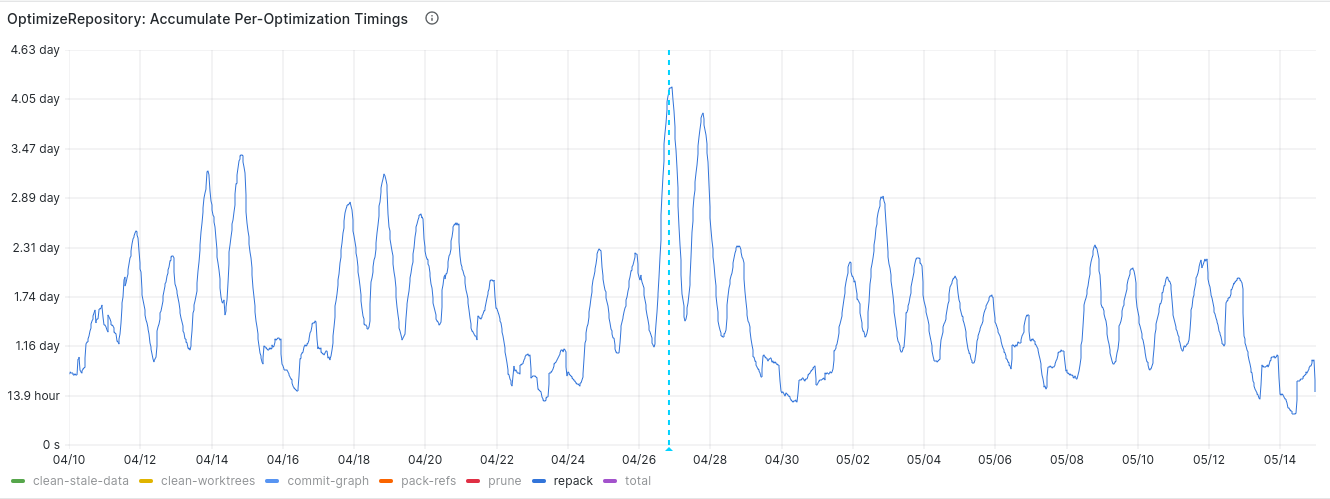Gitaly, the service that is responsible for
providing access to Git repositories in GitLab, needs to ensure that the
repositories are maintained regularly. Regular maintenance ensures:
- fast access to these repostiories for users
- reduced resource usage for servers
However, repository maintenance is quite expensive by itself and especially so
for large monorepos.
In a past blog post, we
discussed how we revamped the foundations of repository maintenance so that
we can iterate on the exact maintenance strategy more readily. This blog post
will go through improved maintenance strategies for objects hosted in a
Git repository, which was enabled by that groundwork.
- The object database
- The old way of packing objects
- The new way of packing objects
- Real-world results
The object database
Whenever a user makes changes in a Git repository, these changes come in the
form of new objects written into the repository. Typically, any such object is
written into the repository as a so-called "loose object," which is a separate
file that contains the compressed contents of the object itself with a header
that identifies the type of the object.
To demonstrate this, in the following example we use
git-hash-object(1) to write a
new blob into the repository:
$ git init --bare repository.git
Initialized empty Git repository in /tmp/repository.git/
$ cd repository.git/
$ echo "contents" | git hash-object -w --stdin
12f00e90b6ef79117ce6e650416b8cf517099b78
$ tree objects
objects
├── 12
│ └── f00e90b6ef79117ce6e650416b8cf517099b78
├── info
└── pack
4 directories, 1 file
As you can see, the new object was written into the repository and stored as a
separate file in the objects database.
Over time, many of these loose objects will accumulate in the repository.
Larger repositories tend to have millions of objects, and storing all of them
as separate files is going to be inefficient. To ensure that the repository can
be served efficiently to our users and to keep the load on servers low, Git
will regularly compress loose objects into packfiles. We can compress loose
objects manually by using, for example,
git-pack-objects(1):
$ git pack-objects --pack-loose-unreachable ./objects/pack/pack </dev/null
Enumerating objects: 1, done.
Counting objects: 100% (1/1), done.
Writing objects: 100% (1/1), done.
Total 1 (delta 0), reused 0 (delta 0), pack-reused 0
7ce39d49d7ddbbbbea66ac3d5134e6089210feef
$ tree objects
objects/
├── 12
│ └── f00e90b6ef79117ce6e650416b8cf517099b78
├── info
│ └── packs
└── pack
├── pack-7ce39d49d7ddbbbbea66ac3d5134e6089210feef.idx
└── pack-7ce39d49d7ddbbbbea66ac3d5134e6089210feef.pack
The loose object was compressed into a packfile (.pack) with a packfile index
(.idx) that is used to efficiently access objects in that packfile.
However, the loose object still exists. To remove it, we can execute
git-prune-packed(1) to delete
all objects that have been packed already:
$ git prune-packed
$ tree objects/
objects/
├── info
│ └── packs
└── pack
├── pack-7ce39d49d7ddbbbbea66ac3d5134e6089210feef.idx
└── pack-7ce39d49d7ddbbbbea66ac3d5134e6089210feef.pack
For end users of Git, all of this happens automatically because Git calls git gc --auto regularly. This command uses heuristics to figure out what needs to
be optimized and whether loose objects need to be compressed into packfiles.
This command is unsuitable for the server side because:
- The command does not scale well enough in its current form. The Git project
must be more conservative about changing defaults because they support a lot
of different use cases. Because we know about the specific needs that we have
at GitLab, we can adopt new features that allow for more efficient
maintenance more readily. - The command does not provide an easy way to observe what exactly it is doing,
so we cannot provide meaningful metrics. - The command does not allow us to fully control all its exact inner workings
and so is not flexible enough.
Therefore, Gitaly uses its own maintenance strategy to maintain Git
repositories, of which maintaining the object database is one part.
The old way of packing objects
Any maintenance strategy to pack objects must ensure the following three
things to keep a repository efficient and effective with disk space:
- Loose objects must be compressed into packfiles.
- Packfiles must be merged into larger packfiles.
- Objects that are not reachable anymore must be deleted eventually.
Previous to GitLab 16.0, Gitaly used the following three heuristics to ensure
that those three things happened:
- If the number of packfiles in the repository exceeds a certain threshold,
Gitaly rewrote all packfiles into a single new packfile. Any objects that
were unreachable were put into loose files so that they could be deleted
after a certain grace period. - If the number of loose objects exceeded a certain threshold, Gitaly
compressed all reachable loose objects into a new packfile. - If the number of loose objects that are older than the grace period for
object deletion exceeded a certain threshold, Gitaly deleted those objects.
While these heuristics satisfy all three requirements, they have several
downsides, especially in large monorepos that contain gigabytes of data.
All-into-one repacks
First and foremost, the first heuristic requires us to do all-into-one repacks
where all packfiles are regularly compressed into a single packfile. In Git
repositories with high activity levels, we usually create lots of packfiles
during normal operations. But because we need to limit the maximum number of
packfiles in a repository, we need to regularly do these complete rewrites of
all objects.
Unfortunately, doing such an all-into-one repack can be prohibitively expensive
in large monorepos. The repacks may allocate large amounts of memory and
typically keep multiple CPU cores busy during the repack, which can require
hours of time to complete.
So, ideally, we want to avoid these all-into-one repacks to the best extent
possible.
Deletion of unreachable objects
To avoid certain race conditions, Gitaly and Git enforce a grace period before
an unreachable object is eligible for deletion. This grace period is tracked
using the access time of such an unreachable object: If the last access time of
the object is earlier than the grace period, the unreachable object can be
deleted.
To track the access time of a single object, the object must exist as a loose
object. This means that all objects that are pending deletion will be evicted
from any packfile they were previously part of and become loose objects.
Because the grace period we have in place for Gitaly is 14 days, large
monorepos tend to grow a large number of such loose object that are pending
deletion. This has two effects:
-
The number of loose objects overall grows, which makes object lookup less
efficient. -
Loose objects are stored a lot less efficiently than packed objects, which
means that the disk space required for the objects that are pending deletion
is signficantly higher than if those objects were stored in their packed form.
Ideally, we would be able to store unreachable objects in packed format while
still being able to store their last access times separately.
Reachability checks
Compressing loose objects into a new packfile is done by using an incremental
repack. Git will compute the reachability of all objects in the repository and
then pack all loose objects that are reachable into a new packfile.
To determine reachability of an object, we have to perform a complete graph
walk. Starting at all objects that are directly referenced, we walk down any
links that those objects have to any other objects. Once we reach the root of
the object graph, we have then split all objects into two sets, which are the
reachable and unreachable objects.
This operation can be quite expensive and the larger the repository and the
more objects it contains, the more expensive this computation gets. As
mentioned above though, objects which are about to be deleted need to be stored
as loose objects such that we can track their last access time. So if our
incremental repack compressed all loose objects into a packfile regardless of
their reachability, then this would impact our ability to track the grace
period per object.
The ideal solution here would avoid doing reachability checks altogether while
still being able to track the grace period of unreachable objects which are
pending deletion individually.
The new way of packing objects
Over the past two years, the Git project has shipped multiple mechanisms that
allow us to address all of these painpoints we had with our old strategy. These
new mechanisms come in two different forms:
-
Geometric repacking allows us to merge multiple packfiles without having to
rewrite all packfiles into one. This feature was introduced in
Git v2.32.0. -
Cruft packs allow us to store objects that are pending deletion in compressed
format in a packfile. This feature was introduced in
Git v2.37.0.
The Gitaly team has reworked the object database maintenance strategy to make
use of these new features.
Cruft packs
Previous to Git v2.37.0, pruning objects with a grace period required Git to
first unpack packed objects into loose objects. We did this so that we can
track the per-object access times for unreachable objects that are pending
deletion as explained above. This is inefficient though as it potentially
requires us to keep a lot of unreachable objects in loose format until they can
be deleted after the grace period.
With Git v2.37.0, git-repack(1)
learned to write cruft packs.
While a cruft pack looks just like a normal pack, it also has an accompanying
.mtimes file:
$ tree objects/
objects/
├── info
│ └── packs
└── pack
├── pack-7ce39d49d7ddbbbbea66ac3d5134e6089210feef.idx
├── pack-7ce39d49d7ddbbbbea66ac3d5134e6089210feef.mtimes
└── pack-7ce39d49d7ddbbbbea66ac3d5134e6089210feef.pack
This file contains per-object timestamps that record when the
object was last accessed. With this, we can continue to track per-object grace
periods while storing the objects in a more efficient way compared to loose
objects.
In Gitaly, we started to make use of cruft packs
in GitLab 15.10 and made the feature generally available in GitLab 15.11. Cruft
packs allow us to store objects that are pending deletion more efficiently and
with less impact on the overall performance of the repository.
More efficient incremental repacks
Cruft packs also let us fix the issue that we had to do reachability checks
when doing incremental repacks.
Previously, we had to always ensure reachability when packing loose objects so
that we don't pack objects that are pending deletion. But now that any such
object would be stored as part of a cruft pack and not as a loose pack anymore,
we can instead compress all loose files into a packfile. This change was
introduced into Gitaly
with GitLab 16.0.
In an artificial benchmark with the Linux repository, compressing all loose
objects into a packfile led to more than a 90-fold speedup, dropping from
almost 13 seconds to 174 milliseconds.
Geometric repacking
Last but not least, we still have the issue that we need to perform regular
all-into-one repacks when we have too many packfiles in the repository.
Git v2.32.0 introduced a new "geometric" repacking strategy for the
git-repack(1) command that will
merge multiple packfiles into a single, larger packfile, that we can use to
solve this issue.
This new "geometric" strategy tries to ensure that existing packfiles in the
repository form a geometric sequence where each successive packfile contains at
least n times as many objects as the preceding packfile. If the sequence
isn't maintained, Git will determine a slice of packfiles that it must repack
to maintain the sequence again. With this process, we can limit the number of
packfiles that exist in the repository without having to repack all objects
into a single packfile regularly.
The following figures demonstrate geometric repacking with a factor of two.
-
We notice that the two smallest packfiles do not form a geometric sequence as
they both contain two objects each.
-
We identify the smallest slice of packfiles that need to be repacked in order
to restore the geometric sequence. Merging the smallest two packfiles would
lead to a packfile with four objects. This would not be sufficient to restore
the geometric sequence as the next-biggest packfile contains four objects,
as well.Instead, we need to merge the smallest three packfiles into a new packfile
that contains eight objects in total. As8 × 2 ≤ 16the geometric sequence
is restored.
-
We merge those packfiles into a new packfile.

Originally, we introduced this new feature into Gitaly in GitLab 15.11.
Unfortunately, we had to quickly revert this new mode. It turned out that the
geometric strategy was not ready to handle Git repositories that had an
alternate object database connected to them. Because we make use of this
feature to deduplicate objects across forks,
the new repacking strategy led to problems.
As active contributors to the Git project, we set out to fix these
limitations in git-repack(1) itself. This led to an
upstream patch series
that fixed a bunch of limitations around alternate object directories when doing
geometric repacks in Git that was then released with Git v2.41.
With these fixes upstream, we were then able to
reintroduce the change
and globally enable our new geometric repacking strategy
with GitLab 16.0.
Real-world results
All of this is kind of dry and deeply technical. What about the real-world
results?
The following graphs show the global time we spent repacking objects across all
projects hosted on GitLab.com.

The initial rollout was on April 26 and progressed until April 28. As you
can see, there was first a significant increase in repacking time. But after the
initial dust settles, we can see that globally the time we spent repacking
repositories roughly decreased by almost 20%.
In the two weeks before we enabled the feature, during weekdays and at peak
times we were usually spending around 2.6 days per 12 hours repacking. In the
two weeks after the feature was enabled, we spent around 2.12 days per 12 hours
repacking objects.
This is a success by itself already, but the more important question is how it
would impact large monorepos, which are significantly harder to keep
well-maintained due to their sheer size. Fortunately, the effect of the new
housekeeping strategy was a lot more significant here. The following graph
shows the time we spent performing housekeeping tasks in our own gitlab-org
and gitlab-com groups, which host some of the most active repositories that
have caused issues in the past:

In summary, we have observed the following improvements:
| Before | After | Change |
|---|



